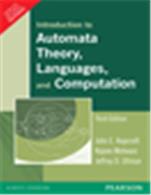Introduction to Automata Theory, Languages, and Computation, 3/e

|
Author(s):
Author:
John E. Hopcroft
- ISBN:9788131720479
- 10 Digit ISBN:8131720470
-
Price:Rs. 970.00
- Pages:554
- Imprint:Pearson Education
- Binding:Paperback
- Status:Available
-
|
This classic book on formal languages, automata theory, and computational complexity has been updated to present theoretical concepts in a concise and straightforward manner with the increase of hands-on, practical applications. This new edition comes with Gradiance, an online assessment tool developed for computer science.
Gradiance is the most advanced online assessment tool developed for the computer science discipline. With its innovative underlying technology, Gradiance turns basic homework assignments and programming labs into an interactive learning experience for students. By using a series of “root questions” and hints, it not only tests a student's capability, but actually simulates a one-on-one teacher-student tutorial that allows for the student to more easily learn the material. Through the programming labs, instructors are capable of testing, tracking, and honing their students' skills, both in terms of syntax and semantics, with an unprecedented level of assessment never before offered.
Table of Content
- Automata: The Methods and the Madness
- Finite Automata
- Regular Expressions and Languages
- Properties of Regular Languages
- Context-Free Grammars and Languages
- Pushdown Automata
- Properties of Context-Free Languages
- Introduction to Turing Machines
- Undecidability
- Intractable Problems
- Additional Classes of Problems
|
Salient Features
- Presents theoretical concepts in a concise and accessible style.
- Emphasizes modern applications of the theory
- Uses numerous figures to help convey ideas
- Provides more detail and intuition for definitions and proofs
- Challenges readers with extensive exercises at various levels of difficulty at the end of each chapter
- Includes additional practice and tests comprehension of important concepts withGradiance an online homework and tutorial system
|
|
|
|
|